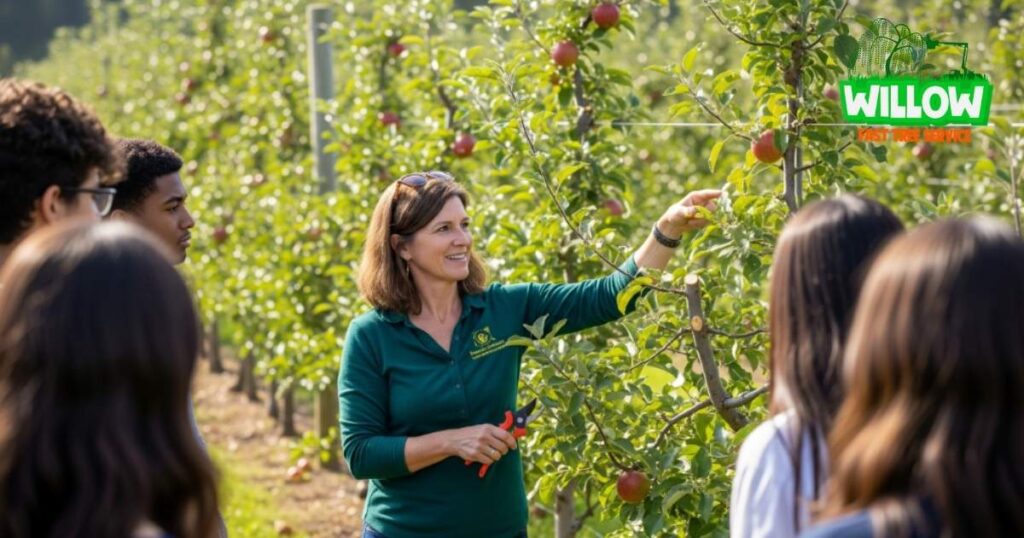Pruning apple trees is one of the most crucial steps in ensuring healthy growth and abundant fruit production; however, doing it incorrectly can be detrimental. That can lead to long-term damage, poor harvests, and even the death of your tree. In Georgia’s warm and humid climate, especially around Norcross and the Metro Atlanta area, timing and technique are everything.
If you’re planning to prune your apple trees this season, here are the most common mistakes to avoid.
Mistake #1 – Pruning at the Wrong Time of Year
One of the most frequent mistakes homeowners make is pruning apple trees at the wrong time.
The ideal time to prune apple trees is late winter to early spring, just before new growth begins. Pruning in fall or early winter exposes the tree to potential frost damage, while summer pruning can remove essential growth needed for fruit production.
Willow Tip: In Norcross and surrounding areas, aim for late January to early March, after the last hard frost but before the trees begin to bud.
Mistake #2 – Cutting Too Much at Once
While it may be tempting to undertake a significant overhaul, removing too much at once can shock the tree and reduce fruit production.
A good rule of thumb: Never remove more than 25-30% of the tree’s live canopy in one season. Over-pruning can lead to water sprouts (weak, vertical shoots), sunburned bark, and increased susceptibility to disease.
Mistake #3 – Leaving Stubs or Ragged Cuts
When pruning, the goal is to make clean cuts close to the branch collar (the swollen area at the base of a branch). Leaving long stubs or making jagged cuts can:
- Delay healing
- Invite pests and fungi
- Disrupt natural growth patterns
Always use sharp, clean tools and make cuts at a slight angle just outside the collar.
Mistake #4 – Ignoring Dead or Diseased Wood
Deadwood doesn’t just make your tree look unhealthy—it attracts pests and spreads disease.
Some common signs of dead or diseased wood:
- Cracked or brittle branches
- Peeling or discolored bark
- Blackened, moldy, or sunken areas
Ignoring these signs can lead to full tree infection. These branches should always be removed first before any cosmetic shaping.
Mistake #5 – Not Thinning the Canopy
Apple trees need proper sunlight and airflow to thrive. A thick, crowded canopy can trap moisture, leading to fungal infections like apple scab and powdery mildew.
Thinning the canopy involves removing small, inward-growing branches and overlapping limbs to:
- Increase sunlight penetration
- Improve air circulation
- Enhance fruit quality and even ripening
Mistake #6 – Using the Wrong Tools
Using dull or inappropriate tools can cause bark to tear, crush branches, and result in uneven cuts. This increases the risk of disease and slows down healing.
Recommended Tools:
- Bypass hand pruners for small branches
- Loppers for medium limbs
- Pruning saws for larger limbs
Willow Pro Tip: Disinfect tools with an alcohol or bleach solution between cuts, especially when working with potentially diseased materials.
Mistake #7 – Pruning Without a Plan
Random cuts can weaken the tree’s natural shape. Every cut affects future growth, so it’s important to prune with intention.
Common pruning strategies for apple trees:
- Central leader: One strong central trunk with evenly spaced branches
- Open center: Vase-shaped, ideal for air flow and sun
Think long-term. Your goal should be a balanced, well-structured tree that supports healthy fruiting.
Tree Pruning Mistakes & Consequences (Quick Reference Table)
| Mistake | Consequence |
| Pruning too early or too late | Frost damage or reduced fruit yield |
| Over-pruning | Weak regrowth, stress, and reduced production |
| Leaving stubs/ragged cuts | Disease entry, poor healing |
| Ignoring dead wood | Spread of pests and infection |
| No canopy thinning | Poor fruit quality, increased disease risk |
| Wrong tools | Bark tearing, slow healing |
| No pruning plan | Unbalanced shape, poor light distribution |
Georgia Climate Tips for Apple Tree Pruning
The warm and often humid conditions in Georgia require special care when pruning apple trees. Here’s how local weather affects your timing:
- Avoid pruning during prolonged wet spells (fungus risk)
- Plan major pruning after the last frost (late Jan – early March)
- Keep an eye on fast spring growth and storm damage
If you’re unsure about your timing, it’s always best to consult a local tree expert.

Final Thoughts – Prune with Purpose, Not Panic
Apple tree pruning isn’t just about cutting branches; it’s about guiding the tree’s growth and health. By avoiding these common mistakes, you can enjoy a more fruitful, vibrant tree for years to come.
Want to make sure your apple trees are pruned the right way? Contact Willow Fast Tree Services today. Our team understands the unique needs of Georgia’s trees and provides expert, affordable service to homeowners in Norcross and the surrounding Metro Atlanta area.
FAQ – Common Questions About Apple Tree Pruning
What happens if you prune apple trees too early?
You risk exposing fresh cuts to frost, which can damage tissue and lead to dieback. Always wait until the end of winter.
Can I prune my apple tree in summer?
Only light pruning—such as removing suckers or water sprouts—is recommended in summer. Significant cuts should be reserved for late winter.
Is it okay to cut large branches off an apple tree?
Yes, but do it with care. Large cuts take longer to heal and can stress the tree. Always cut close to the collar and consider spreading the work over two seasons.
Will apples regrow after poor pruning?
Possibly, but it depends on the extent of damage. Trees can recover with proper care, but fruiting may be delayed by one to two years.
How do I know if I’ve over-pruned my apple tree?
If your tree looks sparse, sunburnt, or is producing excessive vertical shoots (water sprouts), it has likely been over-pruned.

